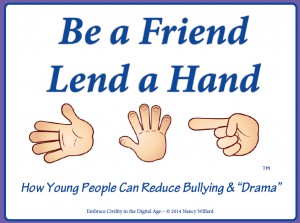You can get the book on Amazon.com:

This web site supports Dr. Russell Sabella's work on educating children, parents, educators and other stake holders about the responsible use of technology. Included in these pages you will find helpful resources, lesson plans, links, and more.

|

|
Webinar To Discuss Internet Safety and Cyberbullying  On October 30,
2014, from 2 to 3 p.m. ET, the Federal
Partners in Bullying Prevention will present "Internet
Safety and Cyberbullying: Keeping Kids Safe" in recognition of
October as both National Bullying Prevention Month and National Cyber
Security Awareness Month. OJJDP will host this two-part Webinar series, which
is a collaborative effort by the U.S. Departments of Justice, Education, and
Agriculture; the Federal Trade Commission (FTC), the Federal Bureau of
Investigation, and the Internet Crimes
Against Children (ICAC) Task Force Program. During this first Webinar,
the FTC will discuss the principles of good digital citizenship, Internet
safety on the go, and aspects of socializing online. Representatives from the
ICAC Task Force Program will explore apps that enable predators to prey on
children, share recent criminal cases, educate audience members about tools
to keep children safe online, and highlight the consequences of
cyberbullying. On October 30,
2014, from 2 to 3 p.m. ET, the Federal
Partners in Bullying Prevention will present "Internet
Safety and Cyberbullying: Keeping Kids Safe" in recognition of
October as both National Bullying Prevention Month and National Cyber
Security Awareness Month. OJJDP will host this two-part Webinar series, which
is a collaborative effort by the U.S. Departments of Justice, Education, and
Agriculture; the Federal Trade Commission (FTC), the Federal Bureau of
Investigation, and the Internet Crimes
Against Children (ICAC) Task Force Program. During this first Webinar,
the FTC will discuss the principles of good digital citizenship, Internet
safety on the go, and aspects of socializing online. Representatives from the
ICAC Task Force Program will explore apps that enable predators to prey on
children, share recent criminal cases, educate audience members about tools
to keep children safe online, and highlight the consequences of
cyberbullying. Resources: Register for this free Webinar. |
@GulfMiddle My pleasure, had a wonderful time with both parents and students. So impressed by how smart and responsible they are.
— Russell Sabella (@rsabella) October 17, 2014
 |



Anne Collier Editor Net Family News
http://www.netfamilynews.org/positive-insightful-new-book-schools-bullying
In the preface to her new book, Positive Relations @School (& Elsewhere), author and risk-prevention educator Nancy Willard tells of a conversation with a very smart 5th grader in a dance class waiting room
UNH Research: National Study Finds Children Helped by Quality Violence Prevention ProgramsDURHAM, N.H. -- A new national study conducted by the University of New Hampshire finds that two-thirds of school-age children in the United States have received some formal bullying or violence prevention program, and it has made a measureable difference for some of them.The researchers found children ages 5 to 9 who had received higher quality prevention education had lower levels of both peer victimization and perpetration. Education was also associated with more disclosure to authorities.“The good news in these findings is that we see some of the safety improvements that the programs are intended to produce,” said David Finkelhor, director of the UNH Crimes against Children Research Center, professor of sociology, and lead author of the study. Finkelhor noted that various national surveys have shown declining rates of peer victimization over the last decade.The research results are reported in the article “Youth exposure to violence prevention programs in a national sample” in the journal Child Abuse and Neglect. In addition, to Finkelhor, the study is authored by UNH Crimes against Children Research Center researchers Jennifer Vanderminden, Heather Turner, and Anne Shattuck, and Sherry Hamby with Sewanee the University of the South.The study failed to find reduced victimization and perpetration among the youth ages 10 to 17 who had higher quality education. Nonetheless, these older youth did make more disclosures about victimization to parents and authorities, suggesting that they had learned something of value.The study suggested there was ample room to improve the programming that young people are receiving. The majority of the programs child received in schools and elsewhere were just a single day presentation with no opportunity to practice. Research has shown that, to be effective, programs need multiple presentations, information to take home, and opportunities to practice, hallmarks of the kind of programs that were associated with improved safety in the present study.Many programs to prevent violence have multiplied in schools, churches and other environments over the last two decades. These programs cover a multitude of topics from kidnapping to Internet safety. The new study found that programs targeted at bullying are the most common at the present moment.“Schools are struggling with resources these days,” said Finkelhor, “but this study suggests that violence prevention has some pay off for students that is worth preserving.”The study, the National Survey of Children Exposed to Violence, was funded by the U.S. Department of Justice, and conducted interviews with a representative sample of parents and children in 4500 families nationwide.

|
